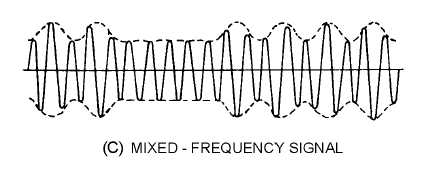3-4
Figure 3-3C.—Heterodyne detection. MIXED-FREQUENCY SIGNAL.
Figure 3-3D.—Heterodyne detection. RECTIFIED MIXED-FREQUENCY SIGNAL.
Figure 3-3E.—Heterodyne detection. AUDIO-BEAT NOTE FROM FILTER.
The cw signal pulsations are removed by the rf filter in the detector output and only the envelope of
the rectified pulses remains. The envelope, shown in view (E), is a 1,000-hertz audio-beat note. This
1,000 hertz, dot-dash tone may be heard in a speaker or headphone and identified as the letter A by the
operator.
The heterodyne method of reception is highly selective and allows little interference from adjacent
cw stations. If a cw signal from a radiotelegraph station is operating at 10,000,000 hertz and at the same
time an adjacent station is operating at 10,000,300 hertz, a simple detector cannot clearly discriminate
between the two stations because the signals are just 300 hertz apart. This is because the bandpass of the
tuning circuits is too wide and allows some of the other signal to interfere. The two carrier frequencies
differ by only 0.003 percent and a tuned tank circuit cannot easily discriminate between them. However,
if a heterodyne detector with a local-oscillator frequency of 10,001,000 hertz is used, then beat notes of
1,000 and 700 hertz are produced by the two signals. These are audio frequencies, which can be







